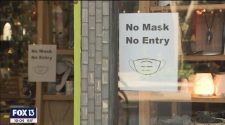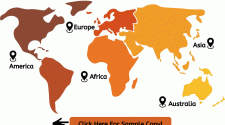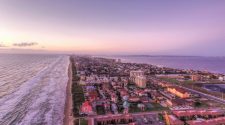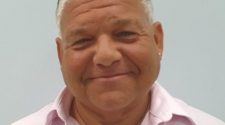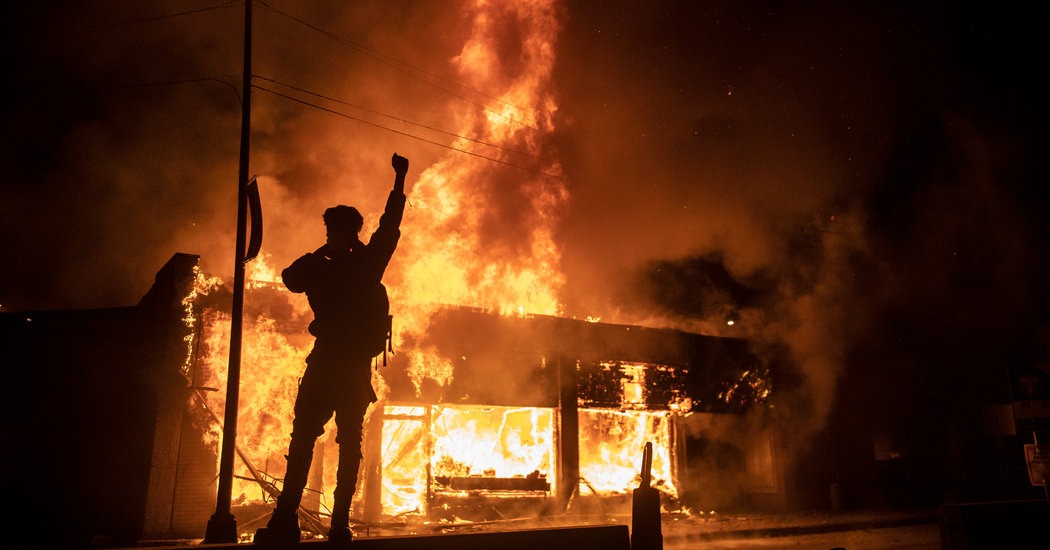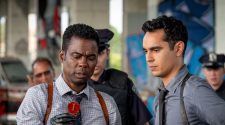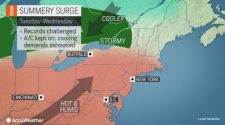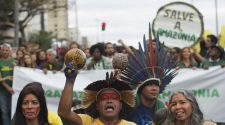Minnesota’s governor activated all National Guard troops but declined the Army’s offer of military police.
Gov. Tim Walz of Minnesota said on Saturday that he was activating thousands of additional National Guard troops to send to Minneapolis after protesters turned out for a fourth night in a row on Friday, burning buildings to the ground and overwhelming officers.
“Our goal is to decimate that force as quickly as possible,” Mr. Walz said of the rioters, a group that he said was different from demonstrators who had been protesting the death of George Floyd, a black man who died after being pinned down by a white officer earlier this week. The former officer, Derek Chauvin, was charged with murder on Friday.
The move by Mr. Walz to activate all of the state’s available Guard troops — up to 13,200 — comes after protesters defied a newly imposed curfew on Friday night and set a string of businesses on fire, including a bank, a restaurant and a gas station.
President Trump said Saturday that the military was ready to step in: “We could have troops on the ground very quickly if they ever want our military.” At his behest, the Defense Department ordered the Army to prepare active-duty military police units to deploy from several army bases to Minneapolis.
Pentagon officials said that Defense Secretary Mark Esper and General Mark Milley, the chairman of the Joint Chiefs of Staff, had spoken with Mr. Walz on Friday to express “willingness” to deploy military police units.
Mr. Walz declined the offer, the officials said, but the U.S. Northern Command nonetheless put several military police units on four-hour status, meaning they could be ready to deploy in four hours, as opposed to a day. Such a move would represent an escalation in the government response to the unfolding events. Military police units were used in 1992 during the aftermath to the Rodney King verdict in California.
Commissioner John Harrington of the Minnesota Department of Public Safety said that there had been “tens of thousands” of people in the streets on Friday, more than any other night since Mr. Floyd’s death on Monday set off a wave of protests that have become increasingly destructive across the country.
Mr. Walz, a Democrat, compared the havoc the protesters had wrought in Minneapolis to wars that Americans have fought overseas, and said he expected even more unrest on Saturday night.
“What you’ve seen in previous nights, I think, will be dwarfed by what they will do tonight,” he said.
More law enforcement officers will be patrolling the streets in Minneapolis and St. Paul than ever before, officials said. Mr. Walz also said he would not rule out requesting a few hundred additional troops from the federal government.
Minnesota officials said it appeared that some of the more violent protesters were from out of the state. The people who defied the curfew on Friday had launched fireworks at police officers, set cars and buildings ablaze and forced Guard troops to retreat at one point, before they returned to clear people away from the Police Department’s Fifth Precinct.
The police began arresting protesters shortly before midnight, when they convened at the Fifth Precinct the day after they had taken over the Third Precinct and set it on fire. Unlike Thursday, the police did not flee from the building.
President Trump on Saturday criticized the authorities in Minnesota for allowing protests to turn violent, and offered the help of the military to contain further protests over the death of George Floyd, which escalated this week with the burning of a police station and other buildings in Minneapolis.
“They have to get tougher, and by being tougher they will be honoring his memory,” Mr. Trump said on the South Lawn of the White House, adding: “When I saw the policemen running out of a police station for that police station to be abandoned and taken over, I’ve never seen anything so horrible and stupid in my life.”
”We have our military ready, willing and able if they ever want to call our military,” he said. “We could have troops on the ground very quickly.”
His comments, paired with a series of tweets on Saturday, threatened to inflame an already tense situation that has played out in protests across the country and in front of the White House.
In one tweet, he called demonstrators who gathered at the White House on Friday night “professionally managed so-called ‘protesters’” and suggested that his supporters would march outside the White House on Saturday.
“Tonight, I understand, is MAGA NIGHT AT THE WHITE HOUSE???” he tweeted.
Asked later whether the tweet might invited more racial violence, Mr. Trump demurred. “These are people that love our country,” he said of his supporters. “I have no idea if they were going to be here, I was just asking.”
“By the way,” he added, “they love African-American people, they love black people.”
Mr. Trump also praised the Secret Service’s response to the earlier White House protest in stark terms and criticized Mayor Muriel E. Bowser of Washington, saying the capital’s police didn’t do enough to contain the protests.
His latest comments came after he injected himself into the national tension over race and police brutality on Friday with tweets that called the protesters in Minneapolis “thugs” and said: “When the looting starts, the shooting starts.” The comment echoed a phrase coined by a Miami police chief in the 1960s about crackdowns on black neighborhoods during times of unrest, and was quickly seized upon by his national critics. Twitter also labeled the tweet as violating its terms of service for “glorifying violence.”
Mr. Trump later said he was unaware of the phrase’s history and walked back his comments, saying that he meant that “looting leads to shooting” and “I don’t want this to happen.”
Attorney General William P. Barr, who has vowed for a swift federal investigation into Mr. Floyd’s death, also weighed in on Saturday, issuing a stern warning to left-wing “agitators” who he said were exploiting the protests to pursue their own goals.
Mr. Barr, at a brief news conference, said outrage over the death of Mr. Floyd, 46, was “real and legitimate,” but said justice must be served through the courts, not through the rioting that has overtaken several of the nation’s largest cities. Mr. Barr warned that protesters who cross state lines to “incite or participate in violent rioting” may be violating federal laws and that the Justice Department would pursue cases against them.
“The voices of peaceful protest are being hijacked by violent radical elements,” Mr. Barr said. “Groups of outside radicals are exploiting the situation to pursue their own separate and violent agenda.”
The United States attorney in Minnesota is investigating the officer’s actions for possible violations of civil rights laws or other federal crimes.
Rallies expanded far beyond Minneapolis on Friday, with protesters destroying police vehicles in Atlanta and New York, and blocking major streets in San Jose and Detroit. Crowds in Milwaukee chanted, “I can’t breathe” and demonstrators in Portland, Ore., lit a fire inside the Multnomah County Justice Center.
Hundreds of demonstrators poured into the streets near Atlanta’s Centennial Olympic Park, smashing windows and clashing with police officers. Not far away, some people climbed atop a large red CNN sign outside the media company’s headquarters and spray-painted messages on it. Others shattered windows at the College Football Hall of Fame, where people rushed in and emerged with branded fan gear.
“What are you changing by tearing up a city?” Mayor Keisha Lance Bottoms said in a news conference. “You’ve lost all credibility now. This is not how we change America. This is not how we change the world.”
Protests in Los Angeles ended with more than 500 arrests. The L.A.P.D. released a statement saying that it was still assessing the property damage, and that “numerous downtown businesses” had been damaged and looted.
The police in Houston arrested nearly 200 people who took part in what they said were “unlawful assemblies” throughout Friday and early Saturday morning. In a Twitter post, police officials said most of those arrested would be charged with obstructing a roadway. In scuffles, four officers received minor injuries, and eight police vehicles were damaged.
In New York, thousands of people attended a demonstration at the perimeter of Barclays Center in Brooklyn. Some hurled bottles and debris at police officers, who responded with pepper spray.
A burned police van was still smoking near Fort Greene Park after two Fire Department trucks pulled away. Protesters slammed its doors off their hinges, threw fireworks into the charred seats, flattened the tires and placed a sign down that read, “Black Lives Matter.”
“I’m just really tired of sitting at home and just doing nothing, basically watching this happen,” said Jason Phillips, 27, of Queens, who was at an earlier protest in Manhattan. “I need to be a part of history. I need to be a part of the change.”
More protests were expected on Saturday, and the city of Portland, Ore. imposed its own curfew for Saturday night.
Minnesota’s top officials acknowledged earlier on Saturday that they had underestimated the destruction that protesters in Minneapolis were capable of inflicting as a newly issued curfew did little to stop people from burning buildings and turning the city’s streets into a smoky battleground.
“Quite candidly, right now, we do not have the numbers,” Mr. Walz said. “We cannot arrest people when we’re trying to hold ground because of the sheer size, the dynamics and the wanton violence that’s coming out there.”
Politicians and the police had not expected the protests to grow for a fourth night on Friday, after a police officer was charged with third-degree murder and a curfew went into effect at 8 p.m. But grow they did, and law enforcement officers struggled to hold their ground, with National Guard troops retreating from angry protesters at one point.
“There’s simply more of them than us” Mr. Walz said of the protesters.
“You’re not getting back at the police officer that tragically killed George Floyd by looting a town,” Mr. Frey said. “You’re not getting back at anybody.”
The intensifying protests came after the authorities announced that the officer who pinned George Floyd to the ground had been arrested and charged with murder on Friday, a development that activists and Mr. Floyd’s family had called for but also said did not go far enough.
The officer, Derek Chauvin, 44, was charged with third-degree murder and second-degree manslaughter, charges that come with a combined maximum sentence of 35 years.
An investigation into the three other officers who were present at the scene remains ongoing.
Mr. Floyd’s relatives have said that had wanted the more serious charge of first-degree murder.
Third-degree murder does not require an intent to kill, according to the Minnesota statute, only that the perpetrator caused someone’s death in a dangerous act “without regard for human life.” Charges of first- and second-degree murder require prosecutors to prove, in almost all cases, that the perpetrator made a decision to kill the victim.
A lawyer for Mr. Chauvin’s wife, Kellie, said that she was devastated by Mr. Floyd’s death and expressed sympathy for his family and those grieving his loss. The case has also led Ms. Chauvin to seek a divorce, the lawyer, Amanda Mason-Sekula, said in an interview on Friday night.
In the year before George Floyd and the police officer now charged with his death, Derek Chauvin, encountered each other on a Minneapolis street, they had worked at the same Latin nightclub. But it was the minutes leading up to Mr. Floyd’s death, as he was pinned on the ground, that the authorities are racing to understand.
Bystanders waved their cellphones, cursed and pleaded for help, and still, for two minutes and 53 seconds after Mr. Floyd had stopped protesting and became unresponsive, the officer continued to kneel.
The fatal encounter began just before 8 p.m. on Monday, when Mr. Floyd entered Cup Foods and a store clerk claimed that he had paid for cigarettes with a counterfeit $20 bill. In the minutes that followed, Mr. Floyd found himself on the ground, beneath the officer’s knee. He called, records say, for his mother. He said, “Please.”
One of the officers dismissed his pleas that he could not breathe.
“You are talking fine,” one officer said, according to the charging documents.
At least one officer was worried: That officer asked if they should roll Mr. Floyd over on his side.
“No, staying put where we got him,” Mr. Chauvin replied.
At 8:24 p.m., Mr. Floyd stopped moving.
Reporting was contributed by Tim Arango, Mike Baker, Julian E. Barnes, Nicholas Bogel-Burroughs, Audra D.S. Burch, Helene Cooper, Manny Fernandez, Thomas Fuller, Matt Furber, Maggie Haberman, Shawn Hubler, Neil MacFarquhar, Sarah Mervosh and Frances Robles.

